The Maria da Penha Law New approaches on old propositions. Where did we move on?
DOI:
https://doi.org/10.15448/1984-7289.2010.2.6484Keywords:
Law 11340/2006 (Maria da Penha Law), Violence against women, Women´s Police Stations, Special Courts for Domestic and Family Violence, Network ServicesAbstract
The aim of this paper is to discuss the obstacles and problems which have been encountered during the implementation process of Law 11340/2006, the Maria da Penha Law. The reflections presented are based on empirical data obtained during the research on “Access to Justice for Women in Situations of Violence. Comparative Study on Women’s Police Stations in Latin America (Brazil, Ecuador, Peru and Nicaragua)”. The survey was conducted between 2007 and 2009 in Belo Horizonte, and had as its core research 15 in-depth interviews with women who experienced violence in marital relations and who sought the women police station to register the incident. From the set of results, we selected some data as well as some thoughts that help to illustrate the daily life of law enforcement in that municipality. This text has reviewed aspects concerning the role of the police, the judiciary and the network of specialist services in assisting women who are victims violence. The goal is to provide elements for the debate about the application of Maria da Penha Law and contribute to its full implementation.Downloads
Download data is not yet available.
Downloads
Published
2010-11-18
How to Cite
Pasinato, W. (2010). The Maria da Penha Law New approaches on old propositions. Where did we move on?. Civitas: Journal of Social Sciences, 10(2), 216–232. https://doi.org/10.15448/1984-7289.2010.2.6484
Issue
Section
Dossier
License
Copyright (c) 2016 Civitas – Journal of Social Sciences

This work is licensed under a Creative Commons Attribution-NonCommercial-NoDerivatives 4.0 International License.
The submission of originals to this journal implies the transfer by the authors of the right for printed and digital publication. Authors retain copyright and grant the journal right of first publication. If the authors wish to include the same data into another publication, they must cite this journal as the site of original publication. As the journal is of open access, the articles are allowed for free use in scientific and educational applications, with citation of the source (please see the Creative Commons License at the bottom of this page).




